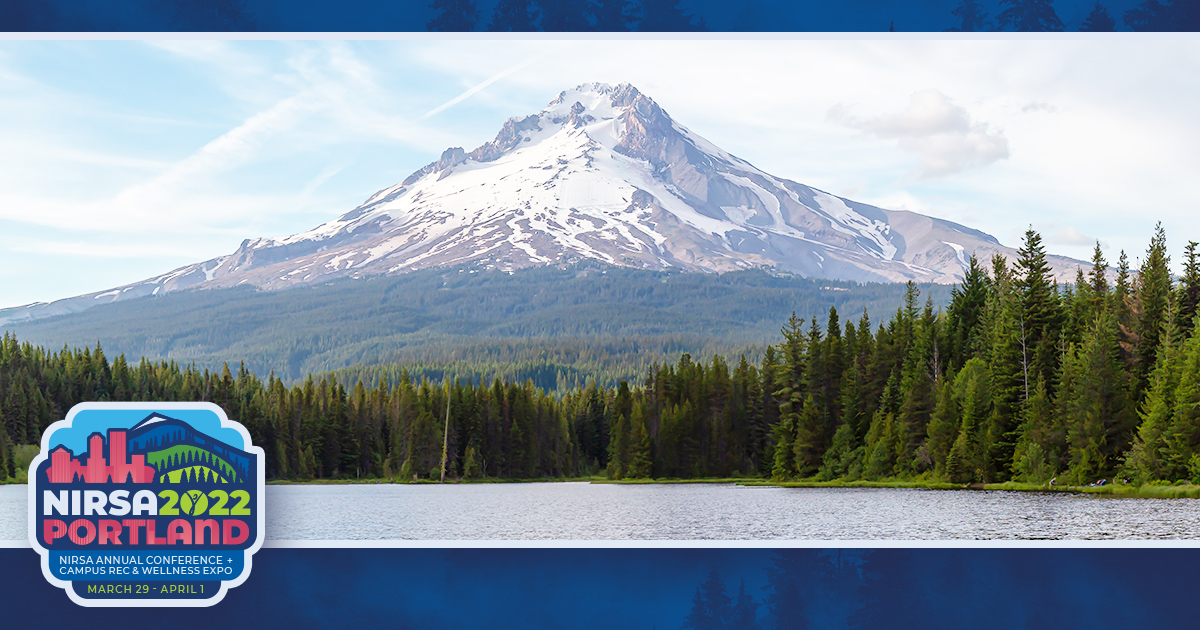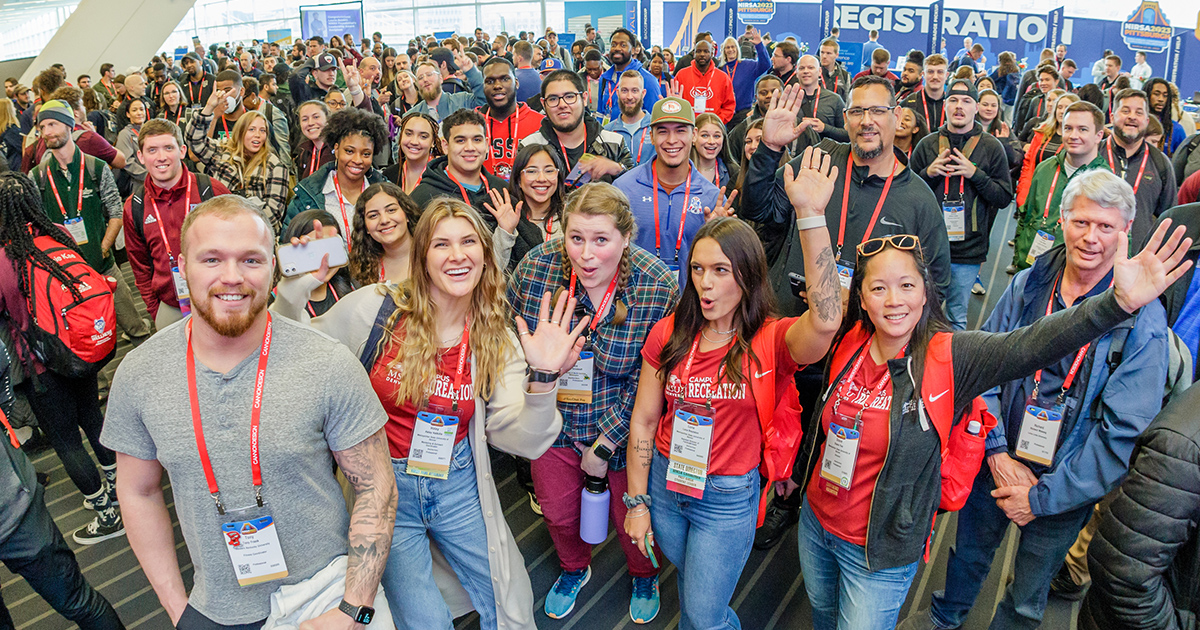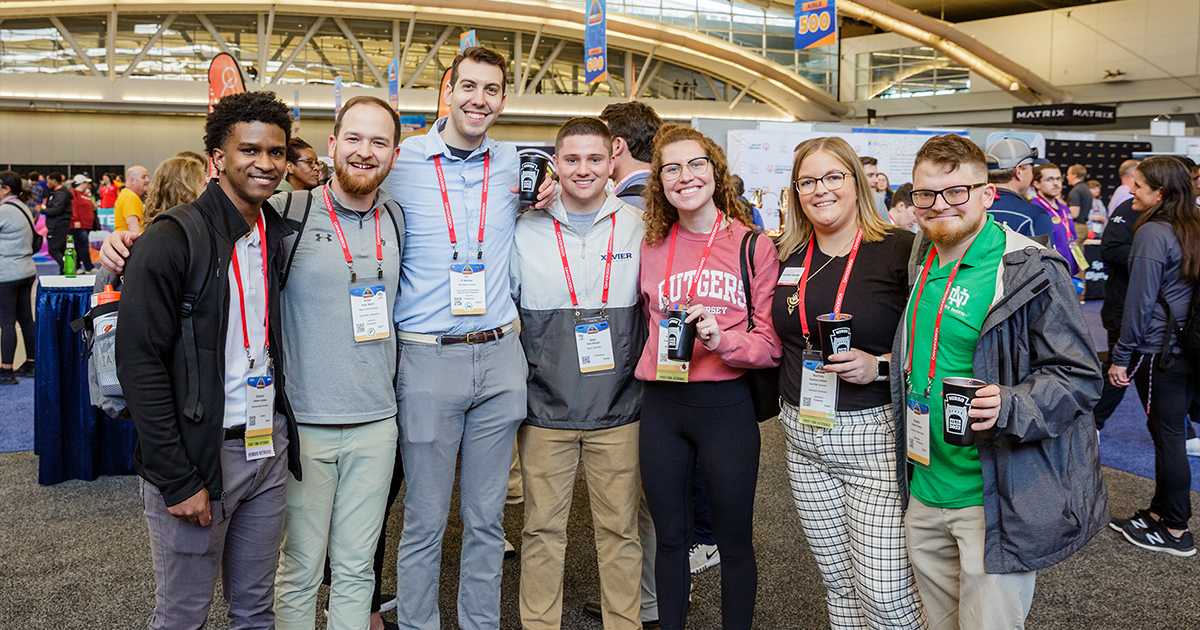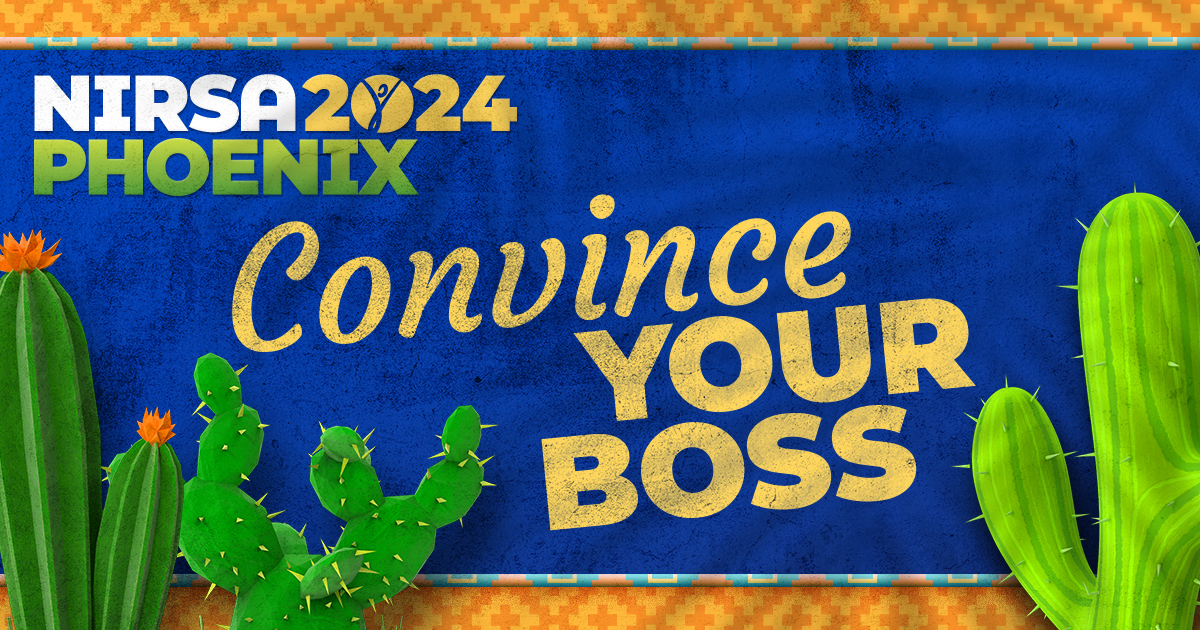The 2022 NIRSA Annual Conference & Campus Rec and Wellness Expo kicks off on March 29, and the Opening General Session will begin the conference program with a land acknowledgement, recognizing the original caretakers of this land who are still in the area and honor First Peoples past and present.
To support the land acknowledgement that will open the 72nd NIRSA Annual Conference, we want to use this space to share additional knowledge about the traditional and ancestral homelands of the Multnomah, Kathlamet, Clackamas, Tumwater, Watlala bands of the Chinook, the Tualatin Kalapuya, and many other indigenous nations of the Columbia River.
Please take some time this week to learn more about how NIRSA’s program of learning happening in Portland, Oregon is a result of the forced sacrifices, continued colonization, systemic violence, and the strategic displacement of the original and rightful stewards of these lands.
Who traditionally lived on the lands where NIRSA 2022 is happening?
Portland is located on the traditional lands of the Confederated Tribes of the Grande Ronde, and the Confederated Tribes of the Siletz Indians.
Confederated Tribes of Grand Ronde
The Confederated Tribes of the Grand Ronde Community of Oregon encompasses over 30 tribes and bands from the Pacific Northwest including western Oregon, northern California, and southwest Washington. For as long as the sun has risen and set, the tribal people have lived and thrived in harmony with the natural landscapes, trading for what could not be found on their lands.
Western expansion impacted tribal peoples’ lives in every way. Forced removal from their ancestral lands began 1853 as the result of numerous treaties between the Tribes and the United States Government. Despite this removal, tribal members maintained their connection to their homelands and areas such as Willamette Falls and Table Rocks.
The Confederated Tribes of Grand Ronde is now governed by the Tribal Council. The Grand Ronde Tribal Council was created by the Tribal constitution. The Council has nine members that are elected for three-year terms.
- Cheryle A Kennedy, Chairwoman
- Chris Mercier, Vice Chair
- Michael Langley, Secretary
- Michael Cherry
- Jon George
- Kathleen George
- Jack Giffen Jr.
- Denise Harvey
- Lisa Leno
Confederated Tribes of Siletz Indians
Additionally, these lands are connected with the Confederated Tribes of Siletz Indians, who “are the most diverse confederation of Tribes and Bands on a single reservation in the United States. Their ancestors spoke 10 completely different languages, each of which had multiple dialects. Their ancestors brought with them deep connections to more than 20 million acres of ancestral territory combined, including all of Western Oregon from the summit of the Cascade mountains to the Pacific and extending into what’s now southwest Washington State and northern California.”
Confederated Tribes of Siletz Indians are governed by a Tribal Council that is made up of nine elected members. The Tribal Council is empowered to exercise legislative power and executive authority over employing legal counsel, matters with the Secretary of the Interior, matters regarding tribal lands and assets, and negotiations with the Federal, State, and local governments.
- Delores Pigsley, Chairwoman
- Alfred “Bud” Lane III, Vice Chairman
- Sharon Edenfield, Secretary
- Robert Kentta, Treasurer
- Frank Aspria
- Lorraine Butler
- Bonnie Peterson
- Angela Ramirez
- Selene Rilatos
Local myths and creation stories
Stories about the creation of the world can offer perspective on a general cultural outlook and offer insight about what life is and how to understand it. By telling people where they come from, they inform who people are.
Below is a Molalla dictation given by Stephen Savage and taken down by Albert Gatschet on the Grand Ronde reservation in 1877.
Now I’m going to tell you a myth.
You should pay careful attention to what I say.
There is a Coyote. He is piling up the earth and stone to make the Big Mountain (Mt. Hood).
The Grizzly comes along. He says to Coyote “Where will you be going?”
Then Coyote says, “I will go yonder inland.”
Then Grizzly says, “What will you be doing there?”
Coyote says, “I will make the world.”
“WHO told you to do that? We best fight it out!” Grizzly says.
Then Coyote says, “No! We should swallow something.”
Then Grizzly says, “No we should fight together.”
Coyote says, “Well, how about if we WOLF-DOWN STONES.”
“WOLF-DOWN! We’ll wolf-down stones!” says Grizzly
Then Coyote says, “These stones we swallow, they should be red-hot!”
“Absolutely so, but how many?” says Grizzly
Then Coyote says, “We will swallow five. First you swallow, then ME, I will swallow.”
“Ok” Grizzly says.
Then Grizzly puts the hot stones in his mouth; then he swallowed five; then he quit swallowing.
Then he says to Coyote “Now you!”
“Ok” says Coyote
Then Coyote puts strawberries in his mouth. Then he swallowed. He only swallows strawberries. He was just fooling Grizzly. Then he swallowed five.
Then he says to Grizzly, “Now all of those stones there, you had better wolf down all of them!”
“Ok” Grizzly says.
Then Grizzly swallowed all the hot stones, a LOT of hot stones. Then the very life was burned out of him. Then he died.
The Coyote thinks, “What should I do now? I’ll go. I’ll never come back this way. This land will live on.”
Then he took the Grizzly, he skinned him, and cut up his body into pieces. He gathered up all the pieces. He threw them everywhere.
Then he threw the heart of Grizzly into Molalla country.
Then he said, “These people here, they will be real hunters, they won’t be a poor worthless sort of people. They will get game. That will be their way in the world to come.”
Additional myths and creation stories are available from the “Confederated Tribes of Siletz Indians: Culture & Language” webpage and the “Native American Creation Myths and Legends” page of native-languages.org.
First Peoples have been strategically displaced from these lands
The forced displacement and removal of the original and rightful stewards of these lands has been strategic. And the abuse of treaties has been used to devastating effect. Common themes from many of the treaties impacting the Confederated Tribes of the Grand Ronde and the Confederated Tribes of Siletz Indians are land consolidation, loss of federal recognition, forced migration, restricted/loss of hunting, fishing, and gathering rights.
How treaties function in the USA
From 1774 until about 1832, treaties between individual sovereign American Indian nations and the United States government were negotiated to establish borders and prescribe conditions of behavior between the parties. The form of these agreements was nearly identical to the Treaty of Paris, which was signed in 1783 and marked the official end to the Revolutionary War between the U.S. and Great Britain. Treaty negotiations ended in a mutually signed pact which had to be approved by the U.S. Congress. Non-tribal citizens were required to have a passport to cross sovereign Indian lands.
From 1832 until 1871, American Indian nations were considered to be domestic, dependent tribes. Negotiated treaties between tribes and the U.S. had to be approved by the U.S. Congress.
In 1871, the House of Representatives ceased recognition of individual tribes within the U.S. as independent nations with whom the United States could contract by treaty, ending the nearly 100-year-old practice of treaty-making between the U.S. and American Indian tribes.
A brief overview of the treaties that affected Confederated Tribes of Grand Ronde & Confederated Tribes of Siletz Indians
The Confederated Tribes of the Grande Ronde and the Confederated Tribes of the Siletz Indians have been subject to many ratified and unratified treaties. Many times, the people claiming to negotiate treaties on the behalf of the United States Government ended up not having the authority to do so and left behind empty promises.
Ratified treaties greatly favored settlers and the United States Government. A detailed list of the treaties that the Tribes and Band of Oregon were subject to between the years of 1853-1855 is available on the Confederated Tribes of Grand Ronde website.
Rogue River Trail of Tears
In the winter of 1856, the federal government began the forced removal of the Umpqua, Southern Kalapuya, Rogue River and Chasta peoples to what would become a 61,000-acre reservation in Oregon’s coast range. This “trail of tears” marched hundreds of native people over 200 miles north across rough terrain during harsh winter conditions. Many did not survive the journey. Similar forced marches also befell the people of the Willamette valley, neighboring peoples from throughout western Oregon, and those along the Columbia River.
“After a period of thirty-three days in which time we traveled a distance of two hundred & sixty-three miles. Started with three hundred and twenty-five Indians. Eight deaths and eight births, leaving the number the same as when started,” wrote George H. Ambrose, an Indian Agent, on March 23, 1856.
Termination and restoration
In 1954, the Western Oregon Termination Act was passed. It called for the termination of federal supervision over the trust and restricted property of numerous Native American bands and small tribes, all located west of the Cascade Mountains in Oregon. The act also called for disposition of federally owned property which had been bought for the administration of Indian affairs, and for termination of federal services which these Indians received under federal recognition. Sixty-one tribes in western Oregon were terminated.
The legislation stripped the Confederated Tribes of Grand Ronde of its federal status and severed the relationship with the federal government. Between 1954 and 1983, Grand Ronde tribal members were a landless people in their own land. The termination policy robbed the Tribe of its social, economic, and political fabric, leaving a scattered population and poverty.
Despite this, Grand Ronde remained a community interconnected by families. Tribal leaders began working in the early 1970s to restore the Tribe’s federal status. They began the arduous task of reestablishing the Confederated Tribes of the Grand Ronde Community of Oregon. They raised money to lobby Congress, testified before lawmakers in Washington DC, and fought for the Tribe’s recognition. Their hard work and dedication were realized on November 22, 1983, when President Ronald Reagan signed the Grand Ronde Restoration Act (Public Law 98-165). Five years later the Tribe regained 9,811 acres of the original reservation when the Grand Ronde Reservation Act was signed on September 9, 1988.
Termination was imposed upon the Confederated Tribes of Siletz Indians by the United States government in 1955. In November of 1977, they were the first tribe in the state of Oregon and second in the United States to be fully restored to federal recognition. In 1992, the tribe achieved self-governance, which allows them to compact directly with the US Government. This gives them control and accountability over our tribal programs and funding.
About the land
After the loss of ancestral lands through the forced migration to a reservation, the Confederated Tribes of Grand Ronde have begun to establish their cultural connections to Willamette Falls. The land is more than land; it is home. The Grand Ronde Tribe has purchased back some of their ancestral lands around Willamette Falls to revitalize the Falls and bring back traditional ceremonies. They have a long history as caretakers of the falls and reestablishing ceremonies and traditions connected to them allows members to reconnect with the culture that has been denied to them for so many generations.
“Willamette Falls represents many things to the Confederated Tribes of Grand Ronde. The existence of Willamette Falls on the landscape represents the physical realization of our oral history and stories. Willamette Falls represents home – the home of our ancestors from the Charcowah village of the Clowewalla (Willamette band of Tumwaters) and the Kosh-huk-shix Village of Clackamas people. They are a portion of our homelands that were ceded to the United States Government in 1855 under the Willamette Valley Treaty (signed January 22, 1855 and ratified March 3, 1855) and where our ancestors were forcibly removed from to the Grand Ronde Reservation. The historical and cultural connection between the Grand Ronde Tribe and Willamette Falls is defined by our ties to this place persisting through generations through forced removal of our tribal members and our own termination by the United States Government.” – From the Confederated Tribes of Grand Ronde Tribal Council’s statement on rebuilding cultural connections at Willamette Falls
NIRSA is committed to equity, diversity, and inclusion
In 2020, the NIRSA Board of Directors adopted the practice of a land acknowledgment at NIRSA-sponsored events. In doing so, the Association seeks to honor the lives that have been lost and the intergenerational impacts of this violence, we must also give thanks to the descendants of these Indigenous/Native tribes who continue to carry on their community’s legacy of resistance, survival, creativity, and brilliance.
On behalf of the Association, I invite you to take some time to explore the cultural treasures that are shared through the Confederated Tribes of Grand Ronde and the Confederated Tribes of Siletz Indians.
Additional reading
Continue learning about the Confederated Tribes of the Grand Ronde and the Confederated Tribes of the Siletz Indians by reading more at:
- Confederated Tribes of the Grand Ronde: Our History
- Confederated Tribes of the Siletz Indians: Our Heritage
- Termination and Restoration in Oregon
- Broken Treaties: An Oral History Tracing Oregon’s Native Population
- For more information about land acknowledgements at NIRSA events, contact the Professional Development team at NIRSA Headquarters.
Richelle Williams is currently the Aquatics & Youth Programs Coordinator at Western Washington University






